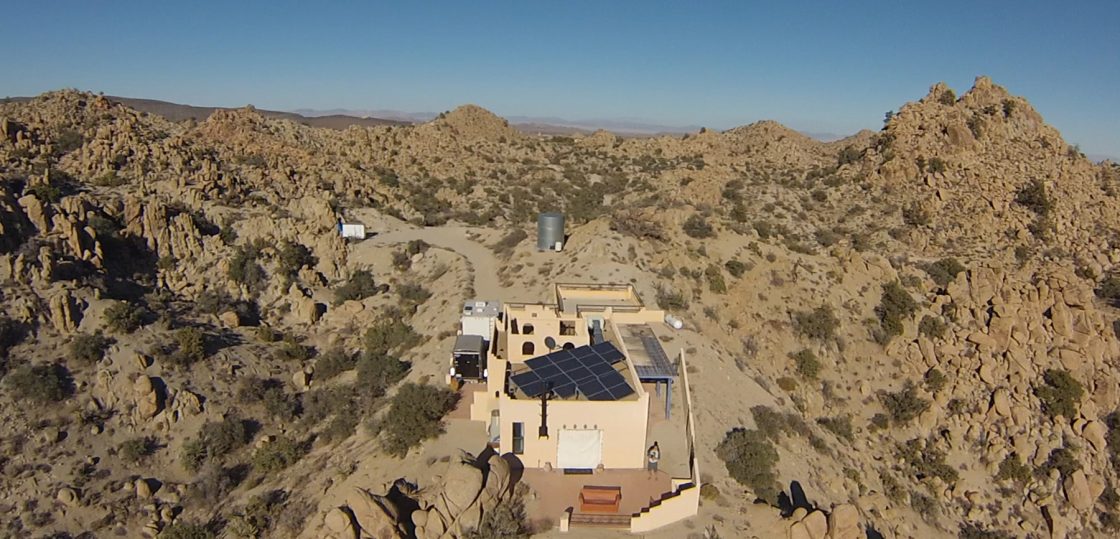In March of 2014 we (me, my wife, and our little dog) moved from San Diego to a little house in Yucca Valley, close to Joshua Tree National Park. It’s a very unique and picturesque area in the High Desert of California. The house itself is also unique, it is completely off the grid. It has no hookups for water, gas, or electricity. The water is delivered to us on a truck every 6 weeks or so, about 2,500 gallons of it. The kitchen and water heater run on propane, which we purchase roughly once a year, and it’s also delivered on a truck. And the electricity comes from the sun.
Off the Grid Solar
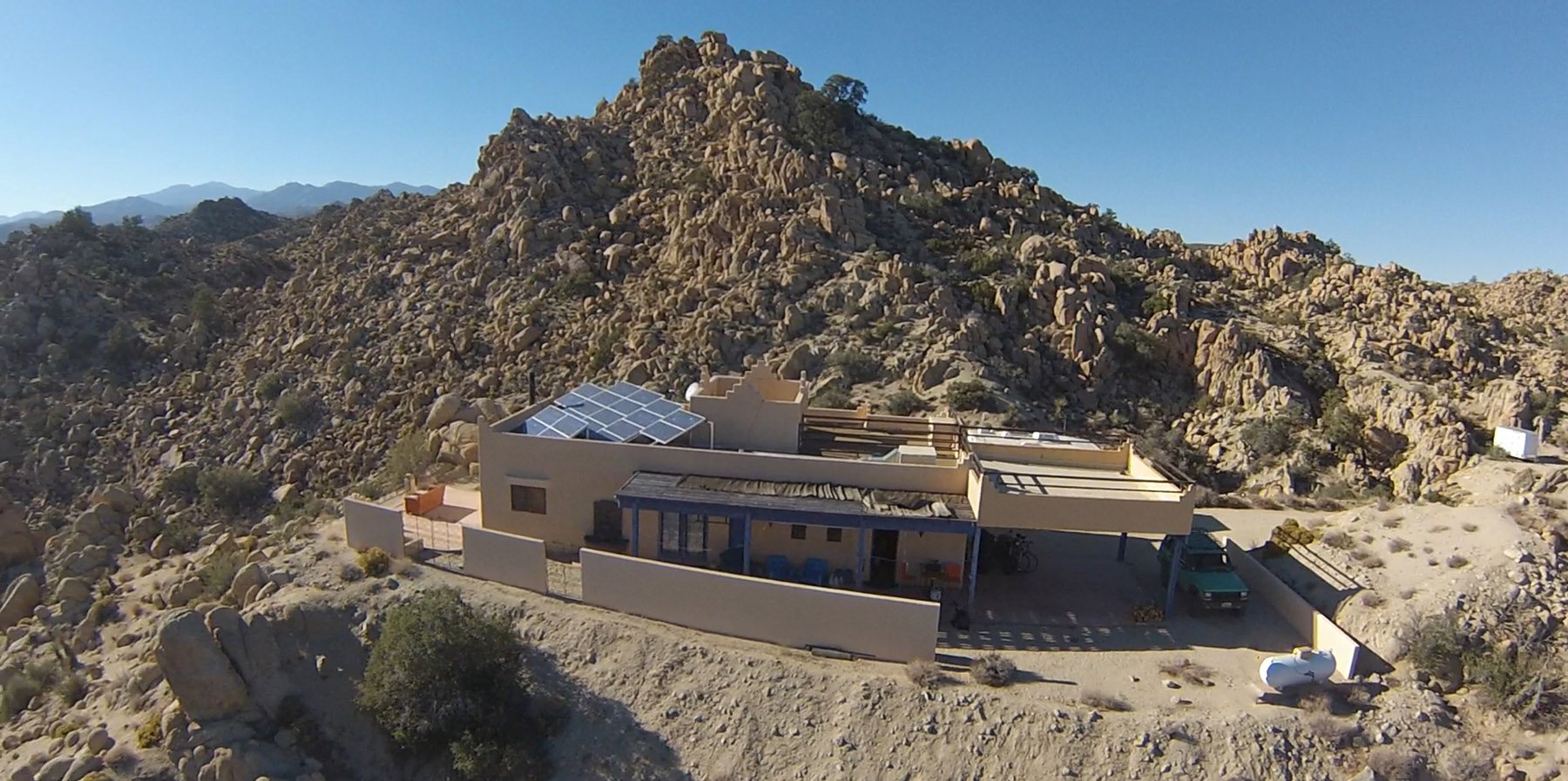
Yes, the house is completely off the grid. During the day a bank of 20 GE solar panels pump out 2.2kW of electricity (at peak efficiency) into a set of 8 huge 6 volt batteries, and at night the batteries power the entire house. But living with “free” electricity isn’t as fun as it might sound at first. 2.2kW sounds like a lot, but for reference, a toaster and a microwave running at the same time would use 2.4 – 3.0kW easily. So you do have to be careful with electricity.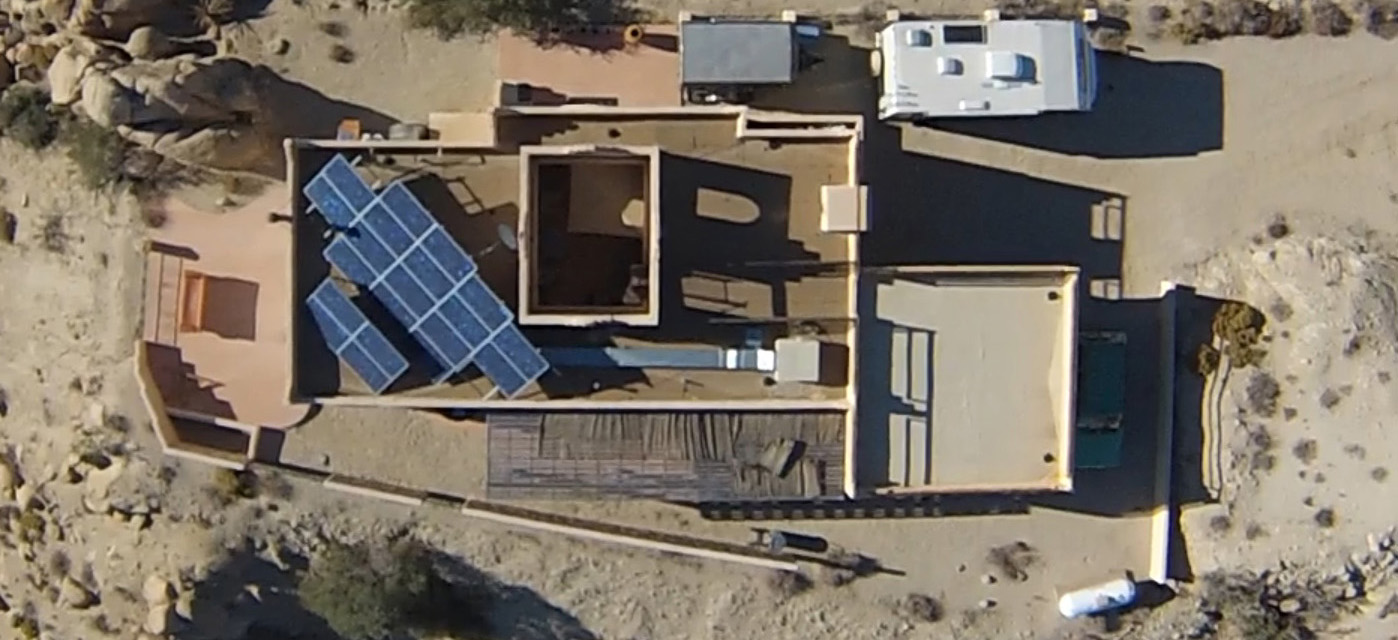
Turning off the lights and such isn’t a big deal. The entire house has energy efficient lighting. With all the lights on we might be using 150-200 watts, at best. But things you may not think about at first do consume surprisingly a lot of electricity. For instance, your average coffee maker will easily pull 1.2kW and a 50 inch flat screen LCD TV will happily consume 250 watts or more. Before moving to an off the grid house, I never bothered to read those little tags on the back of electronics, the ones that tell you how many watts and amps the device in question will pull. Now, it’s the first thing I look at.
We still have the luxury of the microwave, but I like to make fun by saying that our microwave is gas powered. We have a microwave in the RV, parked a few feet from our house. On the rare occasions when we just HAVE to microwave something, we get the generator going. I know, it’s not the most ecologically friendly option, but when you have to microwave, you have to microwave.
Cloudy Days
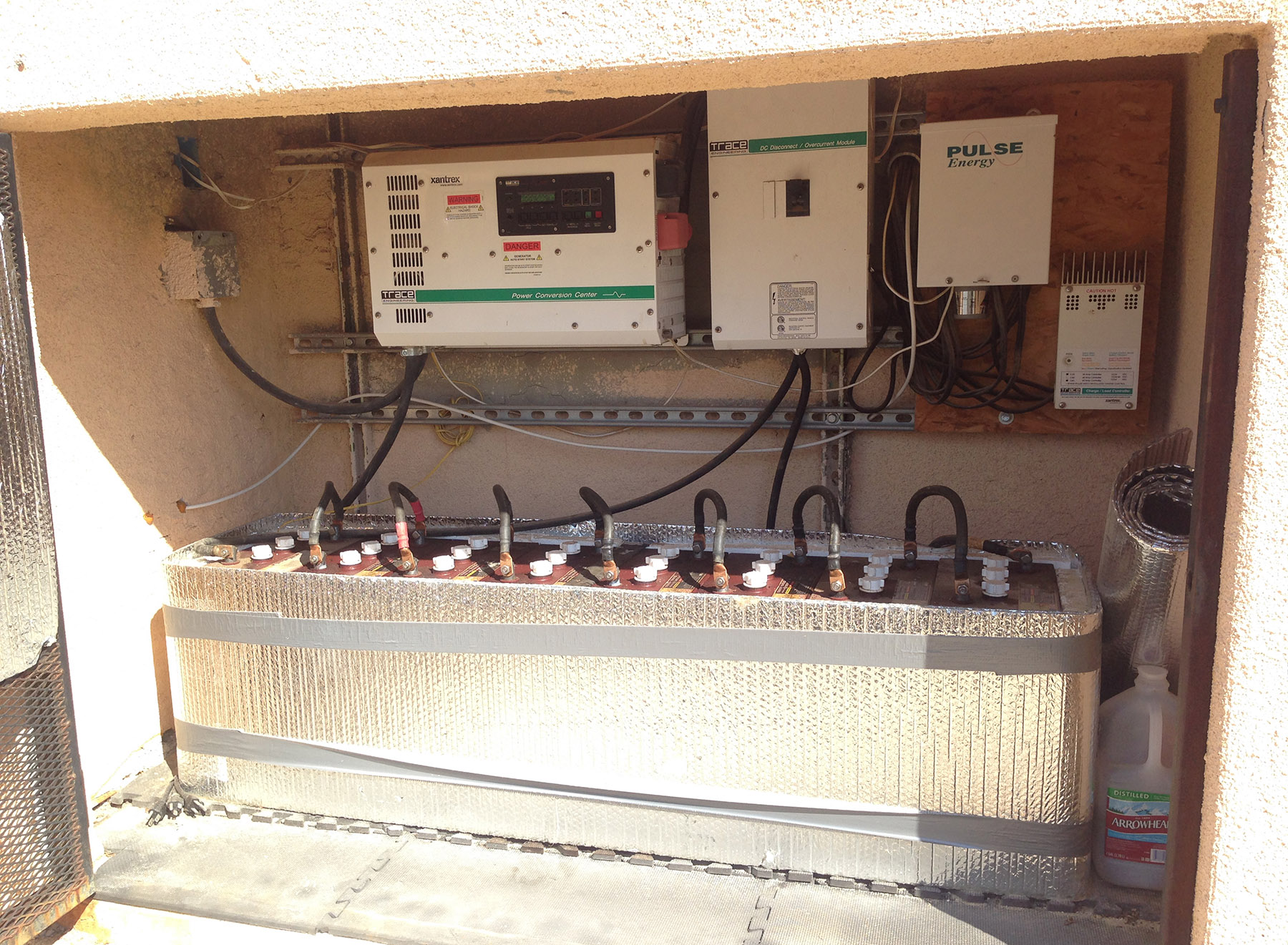
Even though we do live in the desert, it is the high desert, and to my surprise, it rains a LOT out here. And there are also those days, especially in the winter time, when you don’t see the sun for days on end. Our battery bank, when fully charged, is usually good for 1 1⁄2 to 2 days without sunlight. After that… we are back in the stone age! Well, not really, but we do have to connect up the generator.
Before moving out here, we purchased an RV. At the time we were just purchasing it to travel, and as a solid Plan Z. Z for in case of Zombies or if plans A through Y fail. At least with an RV you can never become homeless, or at least that was my justification when I convinced my wife we needed to buy one.
But with the RV came a really nice bonus, something we didn’t count on. A 4,000 watt generator. Yeah, we could have purchased a stand alone unit, but the RV generator has 2 key advantages. It has an electric start, and it sips gas from the same huge fuel tank the RV’s main motor gulps the stuff down from. So with a full tank it can run for well over a week nonstop, if need be.

Once the battery voltage drops below acceptable range (42V for this bank), usually after at least 2 days without any direct sunlight, we hookup the generator, and set it into charge mode. The system that controls the solar panels and the batteries is quite amazing. It can take as much as 60 AMPs at 120 volts! That’s 7.2kW. And it can charge the battery bank at that rate while splitting off what necessary power to run the rest of the house. Unfortunately our generator tops out at 30 AMPs, which is still very good. It usually takes 4-6 hours to recharge the battery bank.
When One Orange Extension Cord Just Will NOT Do
We park the RV about 40 feet from where the battery bank and the controller reside. So to connect the generator to the battery bank, we needed an extension cord. But when you are pumping 30 AMPS of current through an extension cord, you can’t just use any extension cord, you have to use the heavy duty, 8 gauge, super thick type. An extension cord like that costs a lot, and is not available in the local hardware store. The best price we found was on Amazon, for $150 or so. But those who know me well, know that I am a cheap bastard, and I wasn’t about to spend $150 on what amounts to a bunch of wire.
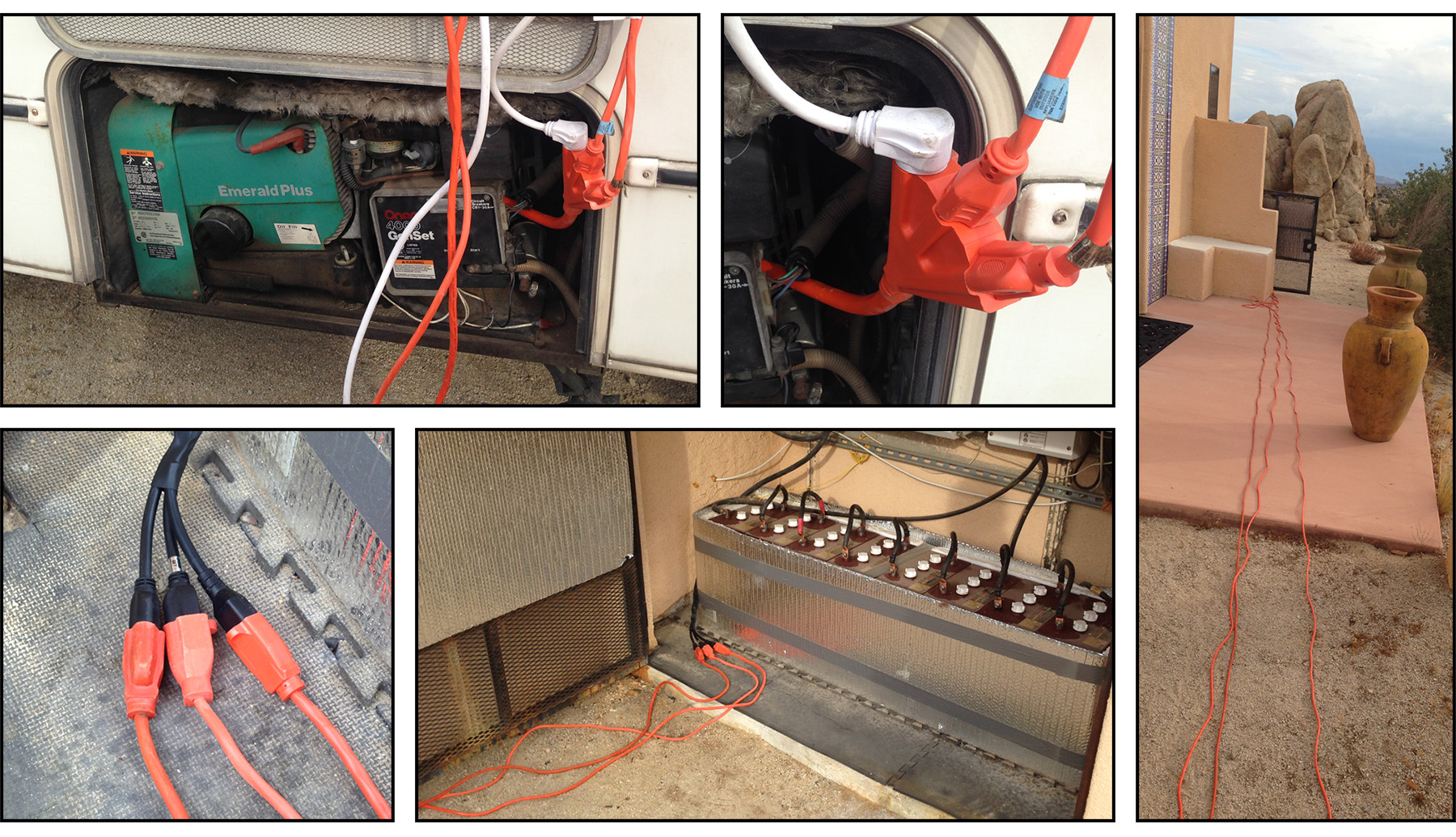
Instead, I had an epiphany. If one extension cord will not do, why not use 2, or better yet, 3! Your average orange extension cord, the kind you find in Home Depot or Walmart, will carry 15 Amps of current for 50 feet, and should carry at least 10 Amps all the way to 100 feet. (Keep in mind, the distance I am talking about here is the length of the cord, not the physical distance between sockets.) Logically then, 2 extension cords should carry 30 Amps, and 3 extension cords should carry 45 Amps.
I decided to go for the overkill, and hookup 3 extension cords in parallel. On the generator side I installed a heavy duty 3 socket plug, wired directly to the main generator breaker. On the battery bank side, I installed 3 plugs cut off from old power supply wires. The total cost for the system was roughly $45, $12 x 3 for the extension cords, and $9 for the plug tripler. That’s compared to $150 for the heavy duty extension cord and another $20 on each end for the specialty plugs you have to use with those types of cords.
But aside of its cheap price, my system has a few key benefits over the traditional heavy duty RV extension cord option. First, I now have 3 nice extension cords, which I can use for other purposes when I am not using them to recharge our house. Second, the generator now has 3 standard size heavy-duty plugs, good enough to plug a welder or any other heavy duty electrical toy. But most importantly, it’s overbuilt to 45 Amps! Try finding an extension cord online that can run 45 Amps for 50 feet.
Before anyone writes back claiming that I don’t know what I am talking about and that 3 x 12 gauge extension cords couldn’t possibly carry more electricity than one 8 gauge cord let me do the calculations. A 12 gauge wire has cross-sectional area of 3.31 sq. mm. An 8 gauge wire has a cross-sectional area of 8.37 sq. mm. 3.31 sq. mm x 3 = 9.93 sq. mm of total cross-sectional area for the three 12 gauge extension cords, which is 19% more than what you get with the 8 gauge cord, for 1⁄4 the price.
Off the Grid Isn’t Necessarily Environmentally Friendly

Aside from the occasional need to run the generator, which only happens once or twice a year, it might look at first glance that this system is very environmentally friendly. Though I haven’t done the calculations yet, I am not so sure about the environmental benefits of living completely off the grid. Day to day, the system is obviously very clean, but the system has 2 huge upfront costs. The solar panels and the batteries. I am not talking about the financial cost, which is substantial, around $12k nowadays if you do the install yourself, probably closer to $18k or more with labor. Instead I want to consider the environmental costs.
The solar panels are getting better every year. The ones we have went up back in 2005, I believe, and I think they should be good for 18-20 years or so. But the Lead Acid batteries are only good for 6-8 years, less if neglected. When we moved in, we had to replace the batteries. The lead in the batteries does get recycled, but the acid and the other chemicals, I am not so certain. I haven’t researched how harmful to the environment that industry is, but sometimes I wonder if all this solar power isn’t doing more harm than normal electricity production due to the battery storage requirement.
Water in the Desert
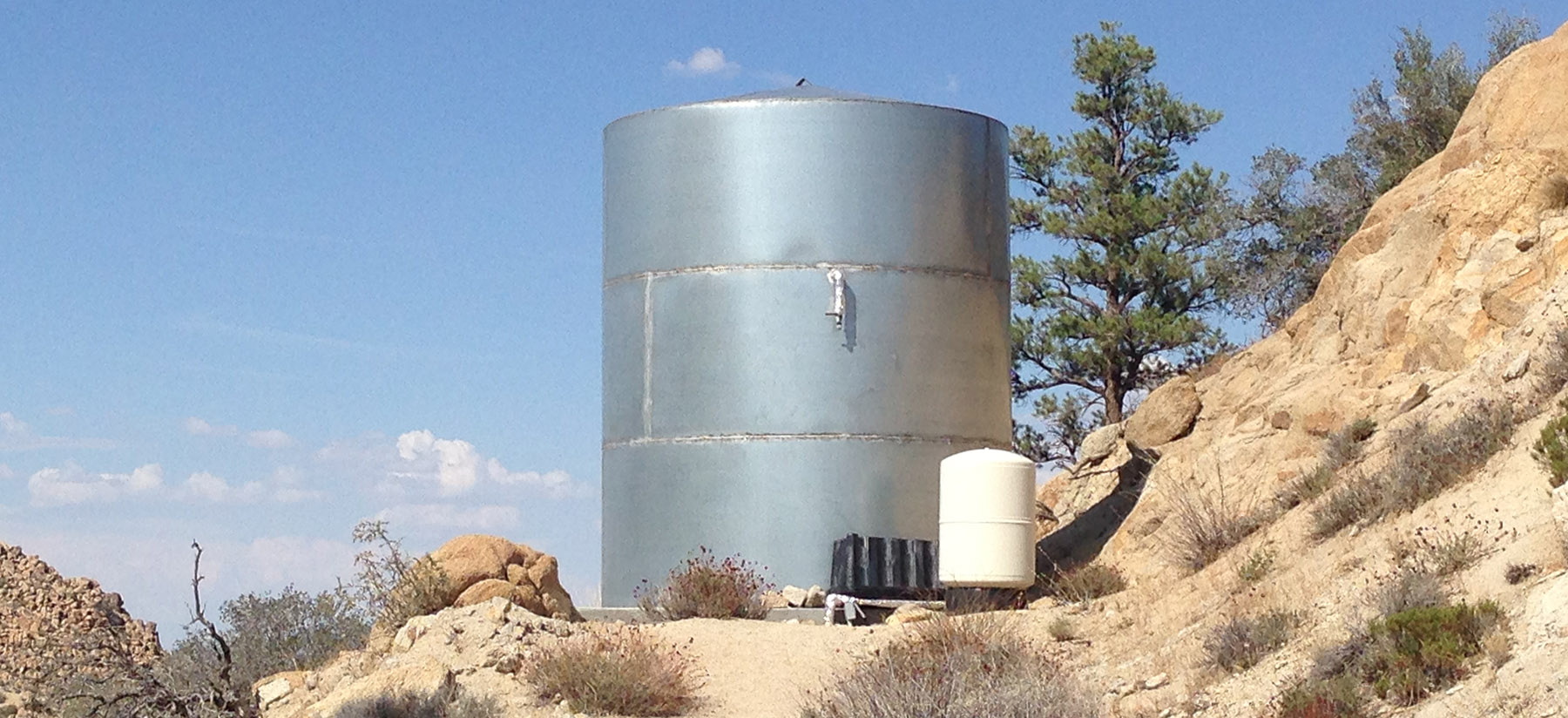
You might write a check for your water service to the City of San Diego, or whatever your local municipality of water company is. We write a check to a guy named Jim! He drives his overloaded 35,000 lb truck to our house and offloads 2,500 gallons of water into our storage tank every 6 weeks or so. We do have the option of building a well, but local wells are drying up nowadays, and drilling 200 feet plus, about how deep we would need to go to get to the water, costs a lot of money. So for now our storage tank does the job.
It’s funny how water conscious you become once you have a limited supply. No more running the water while brushing my teeth. At some point I actually looked into installing a foot activated solenoid, to make it easier to turn on and off the water as we use it quickly. Unfortunately, this house was designed and built by a true artist, someone who clearly never expected that someone one day might need to change any of the fixtures. As a result, all of the fixtures are cemented into the wall. But that’s a story for another time.
Keeping Things Warm
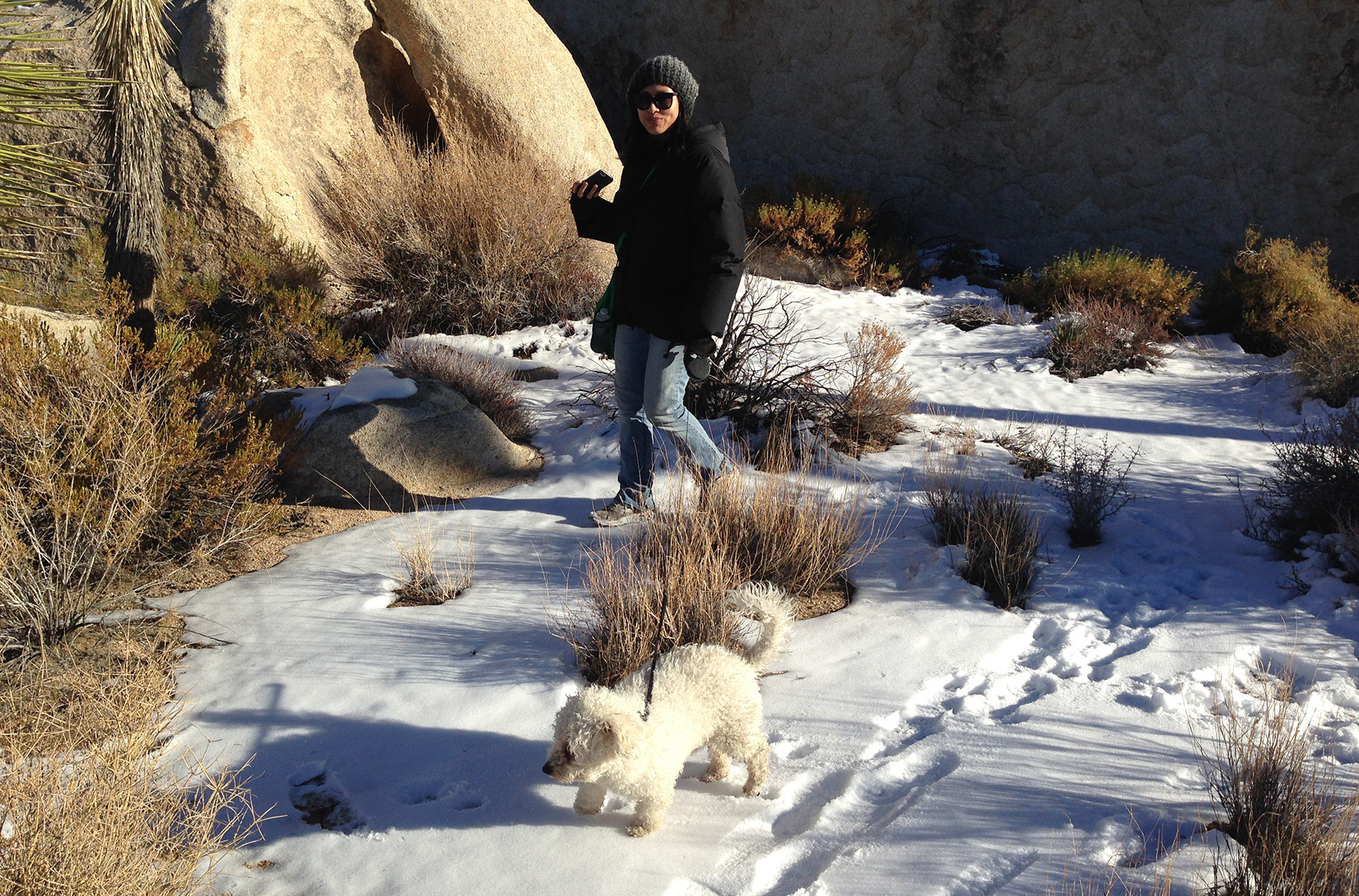
You might be surprised to find out that it snows in the desert. It does indeed, a lot sometimes. It also does get quite cold in the wintertime. During the winter months temperatures range from 20°F to around 45°F. Things usually warm up during the day, but at night the temperature plummets.
Electrical heaters are out of the question, even a tiny space heater will pull 1.2-1.8 kW, and during the winter months we don’t have all that much sunlight to begin with. So as a result we resort to firewood and propane. Our propane tank holds roughly 200 gallons of propane and lasts us the entire year. We use propane in the gas burning fireplace in the living room.
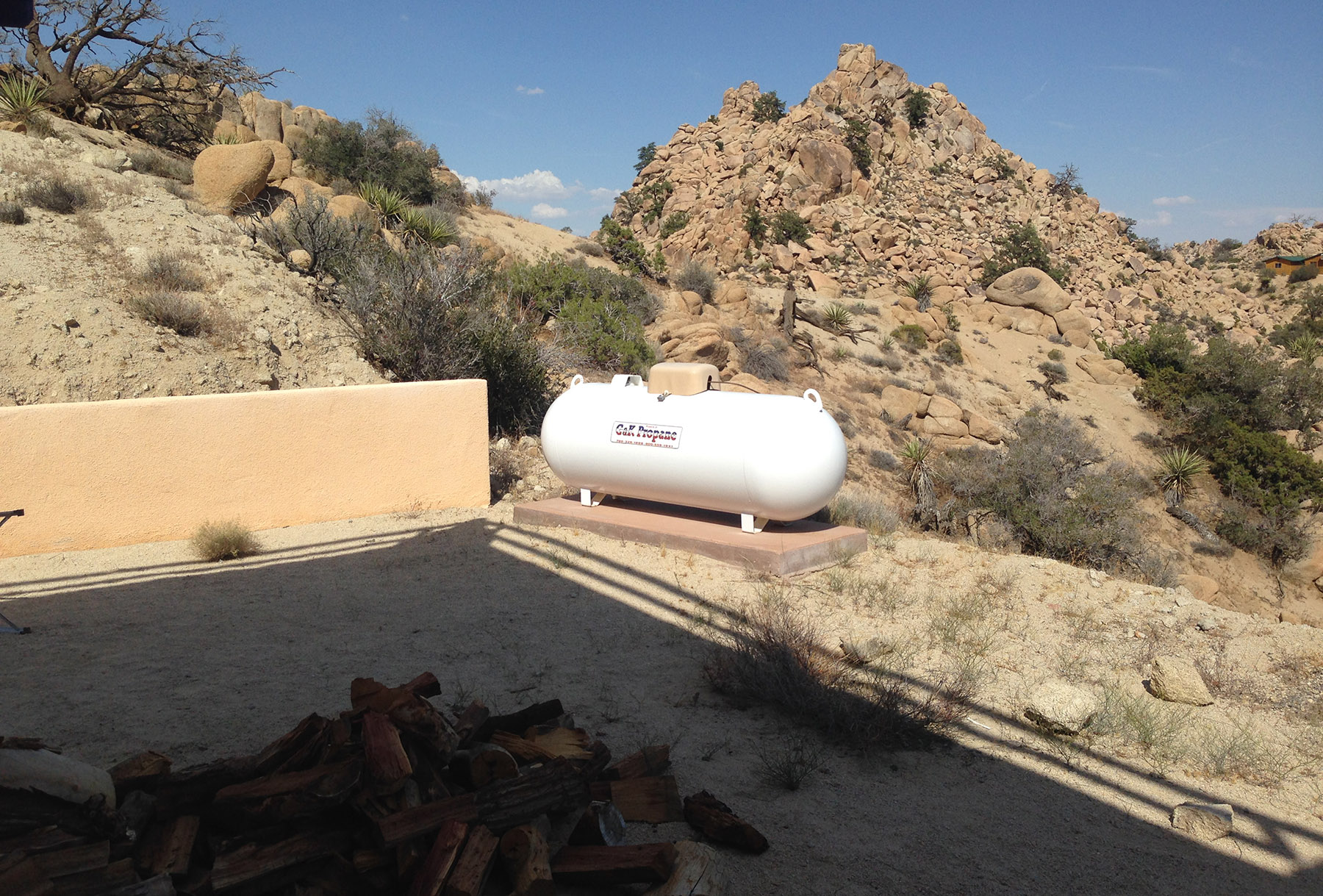
In the bedroom we have a high efficiency wood burning stove. Its ceramic and cast iron construction allows it to quickly build the temperature inside to extremely high levels. Once it’s up to the operating temperature, we can close the oxygen inlet valve and activate the recirculator. The recirculator valve keeps the extremely hot smoke in the burning chamber for longer, allowing for a more complete combustion, and much more heat generation. As a result, we can usually keep the house cozy on 3-5 logs per day.
Off the Grid but Still Connected
Water, heat, and electricity are important, sure. But there is one final utility that one truly cannot live without in todays day and age. I am talking about the internet, of course.
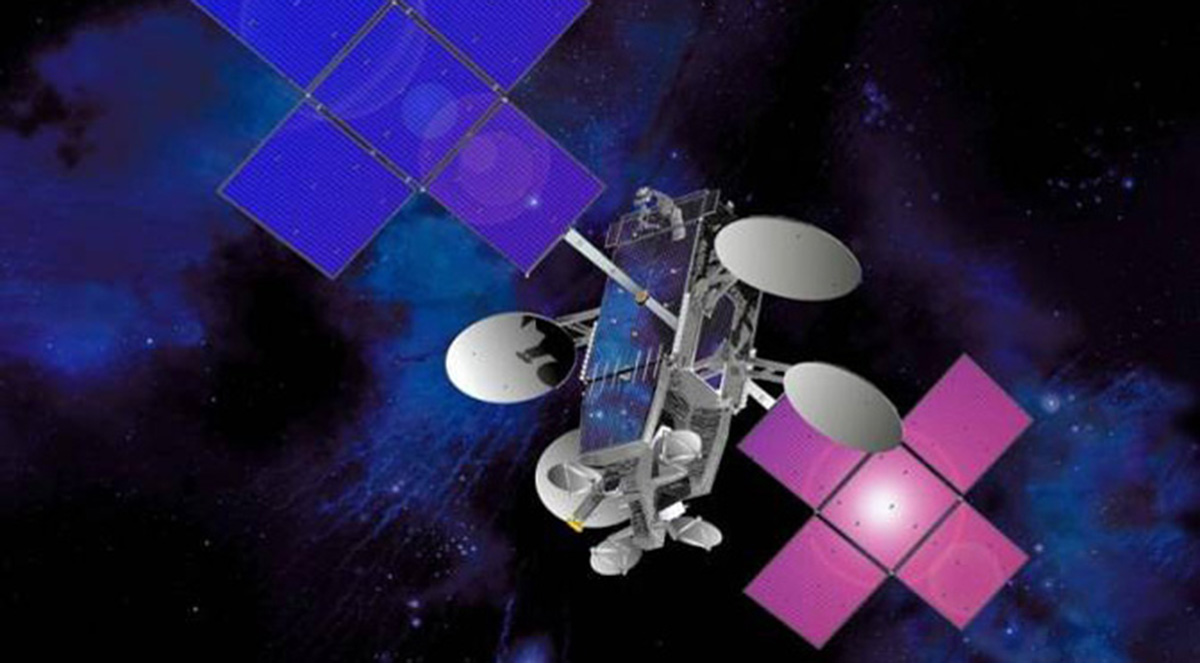
We get our internet from Exede Satellite Internet, a Viacom Company. It’s not something I would recommend, if you have another viable alternative, take it. The actual service from Exede isn’t bad at all, especially when compared to the terrible customer service I used to get from AT&T or COX. You can usually get someone from Exede on the phone in less than 5 min, and it’s usually a US-based operator with ok technical knowledge, and authority to right away solve most problems.
However, the actual satellite internet service is very limiting. At the moment we are on a plan that gives us 15GB per month of any time traffic, and unlimited traffic between hours of midnight to 5 AM. 15GB of anytime traffic is very limiting. No more Netflix for us, at least not before midnight.
The unlimited time slot is really nice though. I have a small server at the house where I queue up all of the files, shows, You Tube videos, and NPR broadcasts I want to download, and at midnight a cron job starts the various download scripts and downloads everything for us.

The speed of the satellite link isn’t bad at all, about 18-20 Mbit down and 5-10 Mbit up. But the real killer is the latency, which makes it hell to do any kind of SSH work on remote servers I administer. On a good day I usually get 600-750ms of base latency. By base latency I mean latency from my house to outer space, around 22,000 miles, and then back down to earth. From there, you have to add in whatever latency you get from normal internet communication. For instance, I administer a server in Amsterdam, and roundtrip latency to that server is around 800ms.
I use Mosh to make it a little easier to get things done, but Mosh only works well directly in the shell prompt. As soon as you open any program, like vi for instance, all the advantages of Mosh disappear.
If we stay here for longer than the originally planned 2 years, I think we are going to investigate shooting a WiFi connection 8 miles or so from a landline connection in town. I already designed the antennas, just need to figure out good placement, and test them out.
Final Thoughts
I hope you enjoyed reading some of my thoughts and rantings about living off the grid in the high desert of California. I know this was a rather quick overview, so if there is any aspect you find particularly interesting, feel free to let me know and ask questions. This article was written with the help of my wife, Yuki. You can find out more about her on her blog at yukitostudio.com.
